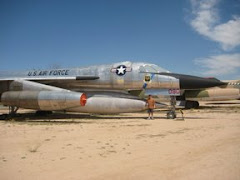
(the F-104D at McClellan Aviation Museum, now Aerospace Museum of California)
On May 10, 1963, (46 years ago today) Captain Victor J. O'Bryan strapped on an F-104C Starfighter for a Napalm and Strafe mission at the Yakima Firing Center. O'Bryan was part of a vast aerial armada that had been moved to the central part of Washington State for Exercise Coulee Crest. This exercise was designed to test the smooth cooperation of the different service branches. Captain O'Bryan was part of the 479th Tacticl Fighter Wing, and the 435th Tactical Fighter Squadron from George AFB. His aircraft would not last the day.
The mission was to rendezvous with an F-100F over the range in Central Washington and have the flight photographed on it's firing passes which would be coordinated by a Forward Air Controller (FAC). Weather was 4000 scattered, high thin scattered, visibilty was 15 miles and the temperature was 60 F. The wind was five miles an hour. The flight consisted of 4 F-104C Starfighters, made by Lockheed for the Tactical Air Command. O'Bryan was the number three man.

Why a thoroughbred fighter plane like the F-104 should be forced to carry bombs and troll around in the mud is beyond me. The F-104 did one thing very well. It went very fast. It was tiny. The cockpit is not far above the ground, in a pinch you could probably get into the cockpit without the benefit of a ladder. It was about 54 feet long with a miniscule wingspan of only 21 feet. Those wings had sharp edges and had special covers so ground crews would not injur themselves while walking around the plane (See photo below). It was difficult to find in the sky and it was very fast. It had one very powerful engine, the J-79, also used on the F-4 Phantom. The C model of the F-104 had a new model of the J-79, its diameter was three inches bigger, giving it about 1000 more pounds of thrust. However, "The F-104C had a number of operational problems with various components. The major offender was the J79-GE-7 engine--forty serious mishaps occurred over a five-year period, destroying 24 aircraft and killing 9 pilots. This led to Project Seven Up, a General Electric modification program for the engine which began in May of 1963 and ended in June of 1964. "* Still, the F-104 could deliver its small payload with devestating accuracy according to most sources.
The flight's call sign was Ritzy. The preflight had stressed safety procedures concerning the armament. The report states that the armorer noted nothing out of the ordinairy during the arming of the gun. Even another pilot from the flight had checked his gun door and felt that it was secure.
The flight took off at 1005 PDT and proceeded to the target area where they contacted Friend X-ray, their FAC. The F-100, call sign Boil 64, joined the formation on the wing of number four at this time. The FAC directed the flight to the target, 55 gallon drums and cardboard troop cut outs. The flight dropped its napalm on the first pass. They then went around for a gunnery pass. O'Bryan did not fire on the first pass because of the smoke from the napalm. At this time, Boil 64 lost his position on the number four aircraft and formed up on O'Bryan's wing for his second strafing pass. At about 2500 feet from the target, O'Bryan opened fire. He had only fired about 100 rounds when he felt a jolt in the aircraft and heard a grinding noise as the gun stopped firing.
O'Bryan interpreted this as a gun jam and initiated a pull up at 100% power when Boil 64 told him a part of his aircraft had just come off. O'Bryan asked him to check out his aircraft and left his power at 100%. Boil 64 indicated that O'Bryan's gunbay door was missing. There was also a hole at the bottom rear of the gun compartment, at this time, O'Bryan began to notice the engine running rugged. His instruments read 700 degrees EGT (Exhaust Gas Temperature), 70% RPM. The aircraft peaked out of the climb at 6000 feet and 240KIAS (Knots Indicated Air Speed) and began a gentle descent. O'Bryan attempted a low-altitude stall clearing procedure. While he was doing this Boil 64 could not slow down enough to stay with him. The procedure worked and RPM increased to 90%, but then the engine stalled again, but more violently than before. His altitude was 4000 and O'Bryan decided it was best to leave the aircraft. He leveled out at 200KIAS. His radio had not come back on line after the stall clearing procedure.
He jettisoned the canopy, and ejected successfully. Pilot and seat separated, but the automatic chute opening system malfunctioned and he had to pull the manual lanyard. He landed safely and was picked up by helicopter within a half hour. The aircraft impacted approximately 14 miles NE of Yakima, Washington. The price of the aircraft is listed as $1,478,402.00.
.
It would appear from the report that there was an explosion of gun exhaust gas, which compromised the gun bay door. It would appear, also, that parts from this explosion were possibly ingested by the engine, which caused the stall. Given the F-104's poor slow speed handling and the fact that it had the glide angle of a brick with wings, it was probably a good idea to depart the aircraft.











No comments:
Post a Comment